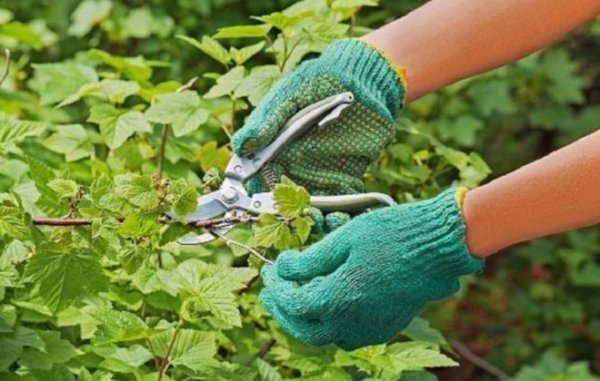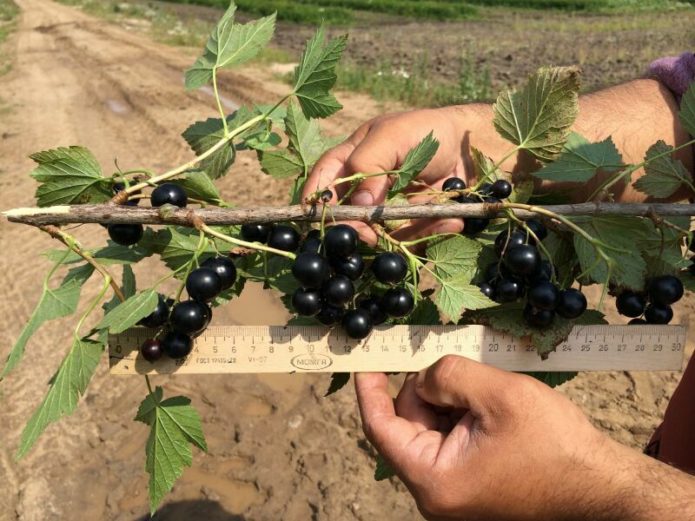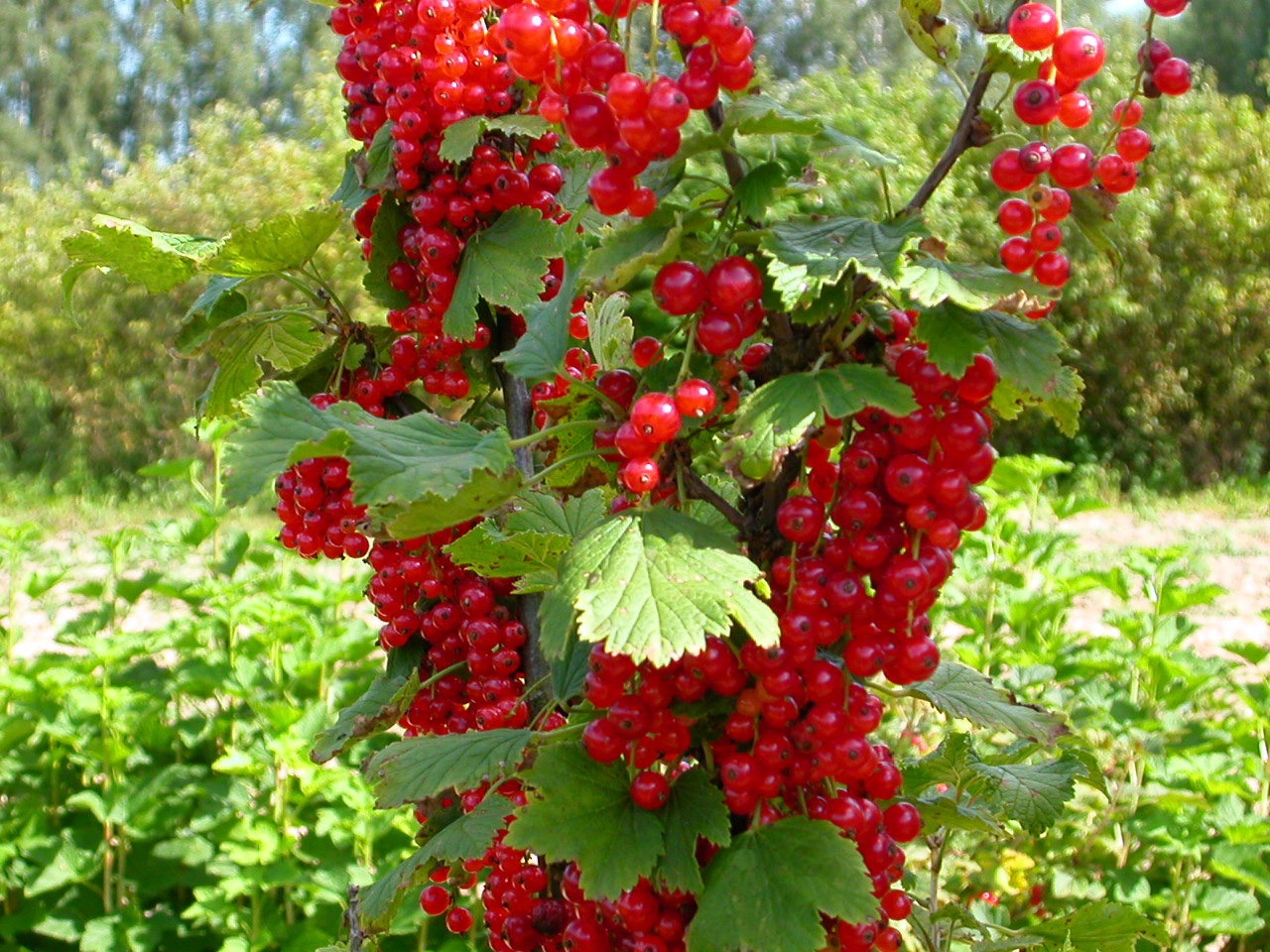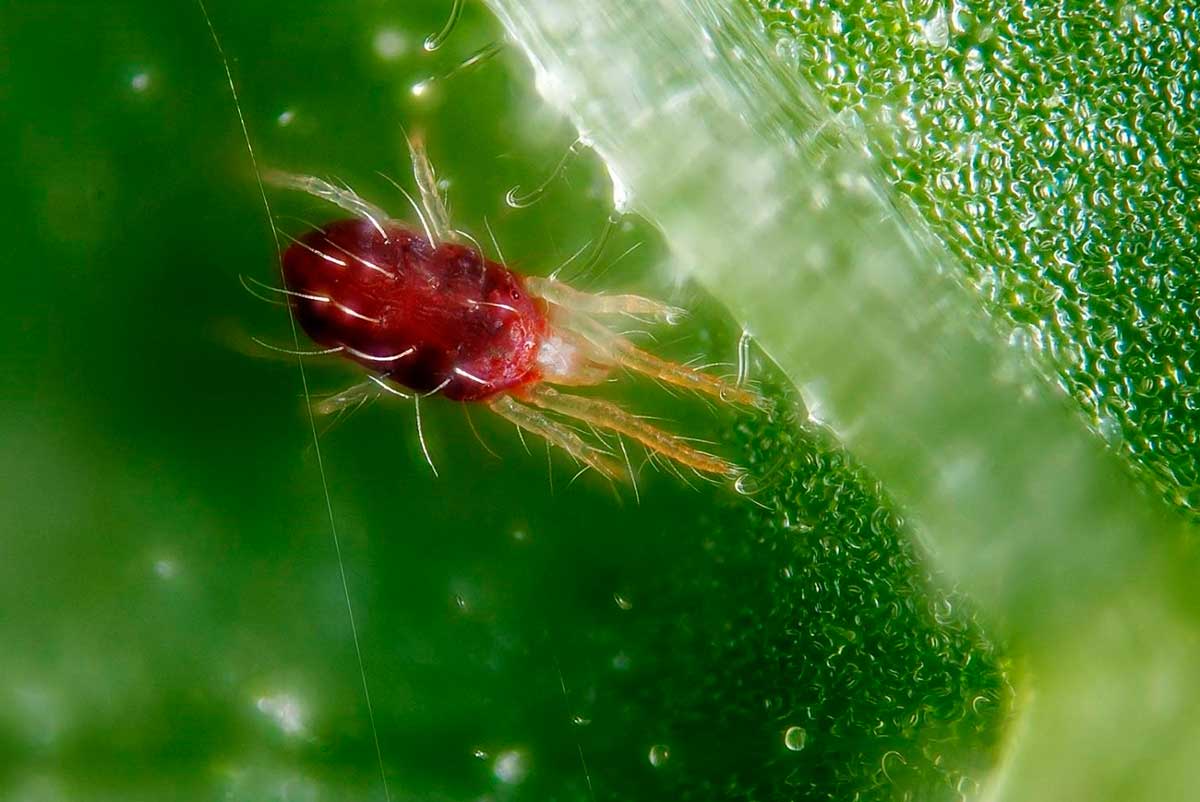Black currant is one of the most valuable berries grown in summer cottages. Currants contain many vitamins and other nutrients. It is relatively easy to get its harvest, but it is necessary to protect the shrub from pests, one of which is the bud mite.
Content
Description of signs of damage to currants by a kidney mite
Kidney currant mite is a representative of four-legged mites. It is very small, the length of adults does not exceed 0.2 mm. The mite is almost white in color, the body is oblong, similar to a worm. This pest lives in the buds, sucks juices from plants, which significantly weakens them and can eventually lead to death. The mite is extremely cold-hardy, it tolerates winter easily.
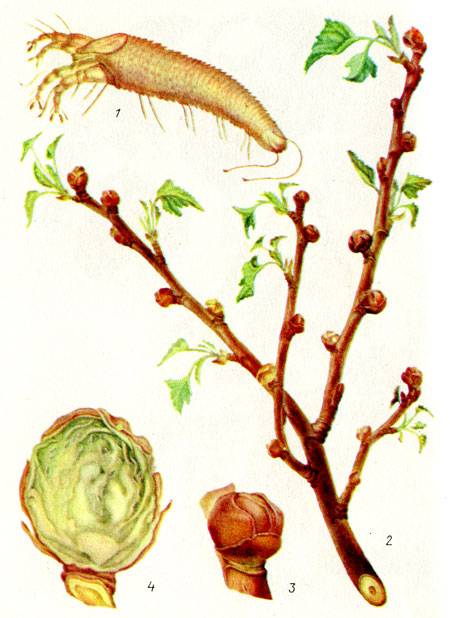
A kidney mite (very enlarged) transforms a healthy kidney into something like a spoiled cabbage head (3, 4)
Tick females lay eggs directly in the kidneys when the air temperature rises to +5 aboutC. The number of eggs in a clutch is enormous; several thousand individuals can hatch from one currant bud. As a result, it swells, becomes round and unnaturally large: this is one of the main signs of mites in the kidney. Juveniles easily spread through the bush, settling in new buds and harming them.
Under the influence of the wind, ticks are transferred to neighboring bushes, and during the period of mass distribution, which coincides with the flowering of currants, they can be seen with the naked eye.
During the season, the female can give up to five generations of offspring, so the kidney mite is considered one of the most dangerous pests. Without the use of protective measures, you can suddenly lose all berry plantings. The results of the defeat of currants with a tick can be manifested in the following:
- in the fall, the affected buds significantly exceed healthy ones in size: if the normal buds are elongated (and the flower buds are roundly elongated and covered with dense scales), then the affected ones are round, unnaturally large, like a diseased head of cabbage;
- in spring, the apical young leaves change color, shape and size in comparison with healthy ones;
- the leaves themselves in the spring and summer become coarse, deformed and discolored;
- the affected shoots lag behind in development, and if the tick also brought viral diseases, signs of a "witch's broom" are added.
The affected bush itself looks unnatural: it is weak, the shoots are curved, there are few flowers and berries, they crumble ahead of time.
How to deal with diseases and pests of currants and how to carry out prevention:https://flowers.bigbadmole.com/en/yagody/smorodina/bolezni-smorodinyi-opisanie-s-fotografiyami-i-sposobyi-lecheniya.html
Video: kidneys affected by a tick
Control measures for kidney mites on currants
The fight against the kidney mite that has appeared on the currant is complicated by the fact that powerful drugs cannot be used during its mass reproduction.It is during this period that flowers bloom and berries are born, and most acaricides (the so-called drugs for the destruction of ticks) are dangerous for bees and other flying insects pollinating flowers. Therefore, the main struggle is carried out in the spring long before the beginning of flowering, as well as in late summer and autumn, after the berries are picked.
Pest prevention
The defeat of currants by a kidney mite cannot be prevented with 100% probability, but the risk can be reduced significantly. For this you need:
- systematically control weeds;
- after falling leaves, collect and burn all the garbage under the bushes;
- timely carry out sanitary pruning of currants;
- planting currants in autumn use only healthy cuttings and seedlings for planting, preferably mite-resistant varieties;
- maintain the immunity of plants with proper agricultural technology (watering, fertilization, etc.).
The risk of introducing a tick significantly reduces the disinfection of seedlings before planting. For this, a 15-minute bathing in water with a temperature of 40-45 is enough aboutFROM.
Hand picking pests
If there is a small amount of pest, you can try to destroy it manually. In the spring, when pruning a shrub, you need to carefully examine each branch, and even better do it in winter. If only a few swollen kidneys are found, they can be torn off and then necessarily burned. However, if there are more than four such buds on some branch, it is better to cut and burn the entire shoot.
Leaving only one infected bud on the bush will cause the ticks to crawl over all branches. If bloated buds are found on many branches, more effective measures must be taken urgently.
Technology of growing currants, features of planting and caring for shrubs in different regions:https://flowers.bigbadmole.com/en/yagody/smorodina/uhod-za-smorodinoy-vesnoy-borba-s-vreditelyami.html
Heat treatment
One of the traditional spring treatments on currant bushes is to process them with very hot water. If done correctly, the mites will be destroyed and the bush will not suffer. Just do not pour water on the branches immediately after it boils, when the temperature is close to 100 aboutC. It is not necessary to measure the temperature specially: while the bucket of water is removed from the fire, poured into a watering can and brought to the bushes, the water will cool down a little, and that will be enough. Until the water from the watering can, raised 15–20 cm above the shoots, reaches them, it will cool down to about 70 aboutC, which is safe for the plant.
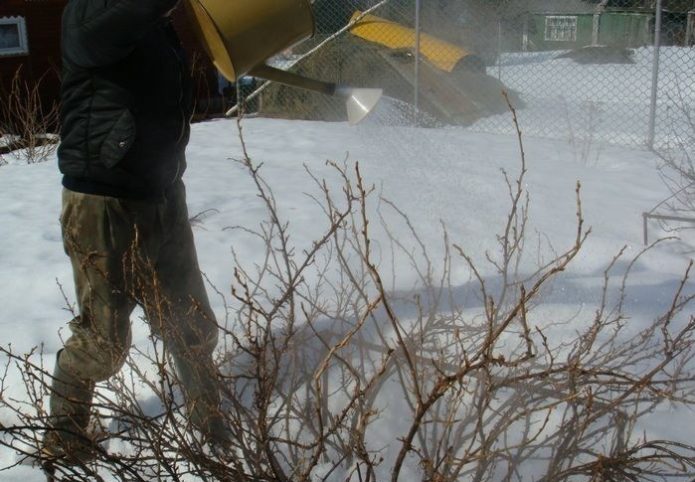
Watering the bushes with hot water, you need to keep the watering can just above the processed shoots
Before processing, the branches should be lightly tied into a compact bush so as not to waste water. Each branch, even the smallest, must be shed from the watering can. It may take 1–2 buckets of water per bush. When is the procedure performed? It is possible even in winter, but in winter it is difficult to do this, so they use boiling water on their first early spring visit to the country, when the kidneys have not yet begun to swell. If the bushes wake up, then we are late with boiling water.
Fire treatment is slightly more dangerous. Using a gas torch or other source of fire, such as a blowtorch, can effectively kill the tick, but there is a risk of damaging the plant. It is necessary to keep the source of flame at a distance of about 10 cm from each branch and adjust the fire so that the pests are bad, and healthy buds are not damaged. The burner is moved along the branches rather quickly, "passing" along each of them 2-3 times. The method is based on the fact that healthy buds are covered with a dense membrane in early spring, and the damaged ones are open, access to ticks is free.
Video: processing currants with boiling water
Folk remedies
It is almost impossible to kill a kidney mite with herbal and home remedies, but they help to slow down its spread.So, in early spring, it is useful to spray the bush with broths of onion husks, garlic or tobacco dust. For example, to prepare a garlic broth, cut 200 g of cloves, pour in a bucket of hot water, bring to a boil again, boil for 5-10 minutes, cool and filter. This broth is sprayed with bushes. They do the same with other raw materials.
Garlic, planted near currants, repels ticks and reduces the risk of infection. In addition, it, like many odorous herbs planted in the garden (thyme, oregano, calendula, etc.) attracts beneficial insects - natural pests of the mite. These are, for example, ladybugs, lacewings, hover flies, etc.
Not everyone knows about the healing properties of this unpretentious and unpretentious distant relative of chrysanthemums and asters, although she has helped healers and doctors to rid people of many ailments for a long time. In most gardens, calendula grows as an ornamental plant, although it has a number of medicinal properties:https://flowers.bigbadmole.com/en/lekarstvennye-rasteniya/kalendula-lechebnyie-svoystva-i-protivopokazaniya.html
Biological preparations
In general, biological products are considered less hazardous to humans and the environment than chemical acaricides. At the same time, in some cases, their activity is no less, but, as a rule, the duration of action is not very long. And most of them still belong to the 3rd class of danger (moderately dangerous). Therefore, when working with them, precautions are required: overalls covering almost all skin, a hat, closed shoes, glasses and, in most cases, a respirator are required.
Bioacaricides are used specifically to kill kidney mites. They are active only in warm weather (at temperatures not lower than 16 aboutC), therefore, they are mainly used during the growing season. In early spring, before the buds have blossomed, it is not often so warm.
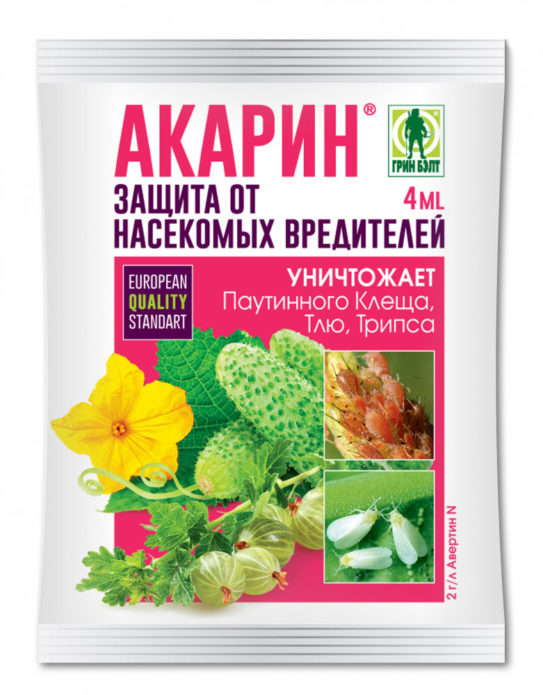
The name of some acaricides even contains the root "cancer", reminding that this is a drug for ticks
Biological products are used according to the instructions, they do it before the end of flowering and after harvesting. In total, 3-4 treatments are carried out per season, preferably alternating between different preparations. The interval between treatments is usually 3-4 days in hot weather and 5-7 days in moderately warm weather.
The most famous biological products are the following:
- Bitoxibacillin (80-100 g of powder per bucket of water), sprayed 2-3 times at weekly intervals;
- Akarin (2 ml per 1 l of water), 2 treatments after 2-3 days;
- Fitoverm (used similarly to Akarin).
All biological products begin to act literally in a few hours, paralyzing the activity of ticks and leading them to death. However, many of them are dangerous for bees, which should be taken into account when using. Manufacturers, perhaps, deliberately exaggerate the toxicity of biological products for humans, but elementary measures for working with solutions must be observed. In addition to the specified workwear, the following should be considered:
- you can work with such substances for no more than 4 hours;
- during work, do not drink, smoke, eat;
- after work, disposable items of equipment are destroyed (burning, deep burial), the rest are washed or washed;
- in case of poisoning (as a rule, the appearance of nausea, dizziness, weakness), they stop working, take 8-10 tablets of activated carbon or other sorbents, after a few minutes they drink up to a liter of water and induce vomiting. If possible, they immediately consult a doctor.
As a rule, the above measures are necessary in case of accidental ingestion of a large amount of a biological product. In mild cases, a doctor may not be required.
Chemical acaricides
Not every insect control chemical works on ticks. For their extermination, acaricides and insectoacaricides are used. Almost all of them are dangerous for humans: some have the 3rd hazard class, but the most active are the 2nd (highly hazardous substances). Therefore, they try not to use them without obvious need, and if necessary, they take all possible and necessary precautions. These are actually the same measures as in the case of biological products, but they must be taken much more seriously.
Acaricides must be applied three times over the entire season:
- in early spring, destroy overwintered females and larvae that have already emerged from the eggs;
- with the onset of warm weather, destroy the larvae that did not have time to appear in early spring and hatched later;
- after the final collection of berries, carry out a safety treatment to destroy the remaining young ticks.
As in the case of biological products, it is desirable to alternate chemical acaricides. The most popular in the fight against kidney mites are Vermittek, Aktellik, BI-58, Rogor-S, etc. All these drugs are used both in the first half of the growing season and after harvest.
For example, an ampoule of Aktellik with a volume of 2 ml is designed to prepare 2 liters of solution, which, with proper use, will be enough for 2 adult bush. The active ingredient in its composition is pirimiphos-methyl, belongs to the class of organophosphorus compounds. Therefore, the last processing of currants should be carried out no later than a month before harvesting.
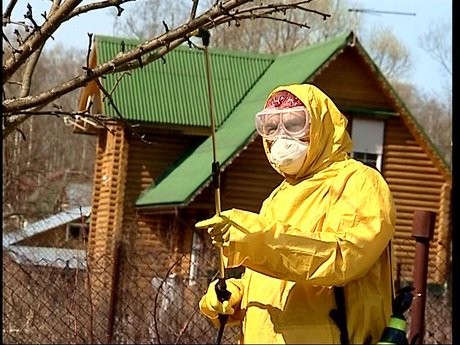
When working with drugs of the 2nd hazard class, it is better to play it safe, no matter how the neighbors joke about your appearance
Among the analogues of the drug, there are many well-known ones: Aktara, Konfidor, Kleschevit, etc., but in recent years it is Actellik that has become very popular. Vermitic (a drug based on abamectin) is used in the same way, dissolving 3 ml of the drug in 10 liters of water. Its protective effect lasts for 2-3 weeks. At the same time, surprisingly, the manufacturer claims that the harvest can be harvested within a few days after processing.
BI-58 (dimethoate is an active substance in its composition), according to the description, has a 3rd hazard class, therefore, it is possible to contact the treated plants after 3-5 days, but it acts on the tick for up to a month. Consumption - ampoule for 5 liters of water (2-3 currant bushes). Rogor-S is practically an analogue of BI-58, it contains the same active ingredient.
In addition to powerful acaricides, drugs based on the action of colloidal sulfur do a good job with kidney mites. The plus is that they are not very dangerous for warm-blooded animals, humans and many beneficial insects.
For example, one of the relatively new drugs - Tiovit Jet (50-60 g of powder per 10 liters of water) - is very easy to use, belongs to the 3rd hazard class, and the exit for work after its use is possible in 3-4 days. In addition to acaricidal action, it also has a fungicidal effect: it also successfully fights against fungal diseases, first of all, with such common ones as powdery mildew. The only limitation is that it must be applied in warm weather.
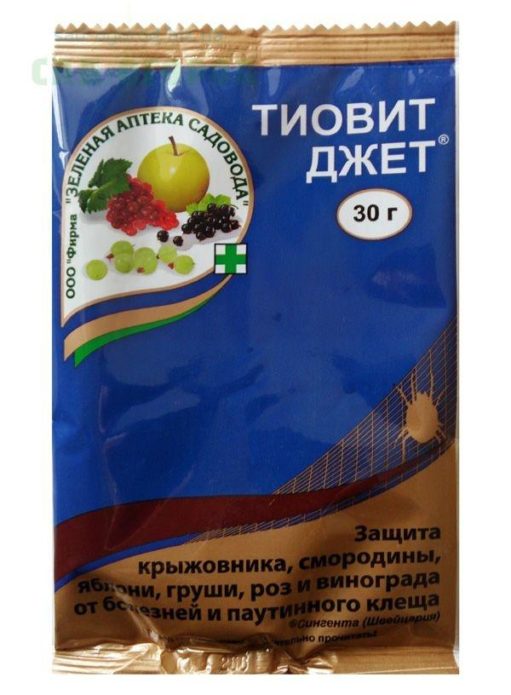
Tiovit Jet, which quickly gained popularity in the fight against diseases, is also active against ticks
Blackcurrant varieties resistant to kidney mite infestation
Currently, the list of black currant varieties allowed by the State Register of the Russian Federation for cultivation in our country includes more than 200 names, and new ones are appearing that have not yet been registered. Among them are a significant number of varieties that are more or less resistant to kidney mite infestation. Obviously, it is not possible to consider all these varieties, but a short list of quite popular ones is as follows.
Memory Michurin (one of the oldest, well-known varieties, grown for almost 60 years). Early ripe, yield up to 4 kg per bush. It is characterized by instability to powdery mildew, but relatively high resistance to infestation with kidney mites.
Other early ripening varieties include:
- Sevchanka.The variety is highly resistant to ticks, most diseases and the vagaries of the weather. The yield of rather large berries and their consumer qualities, judging by the gardeners' reviews, are very high.
- Selechenskaya-2. A variety with a tasting score of 5.0 points. It is almost not affected by pests, the berries are large, the yield is high.
- Exotic. A variety with berries characterized by an excellent taste, frost-resistant, almost not affected by a tick, but the yield of the variety is below average.
Among the varieties of currants of the average ripening period, the following are considered relatively resistant to the action of the pest:
- In memory of Potapenko. High-yielding, very winter-hardy variety. Large fruits were awarded 4.5 points by tasters. Kidney mite resistance is high.
- Riddle. Mite resistance is considered to be slightly higher than average, with a yield of about 3 kg per bush. It is appreciated for its excellent presentation.
Many gardeners believe that the most valuable varieties are medium-late ripening. One can argue with this, there are different opinions, but there are many medium-late varieties of currants, some of them are resistant to the action of a kidney mite, for example:
- Kipiana. A high-yielding variety, berries of good taste, sweet and sour. Resistant to most diseases and pests.
- Nuclear. A variety that is slightly affected by a tick. Medium yield, very large fruits are described as good.
- Katyusha. The berries are medium-sized, but tasty, the yield is average. Transportability is excellent. The incidence of the tick is small.
- Mermaid. One of the best varieties of berries of medium late ripening in terms of quality, but it is characterized by a low yield. Possesses complex resistance to the action of pests, common currant diseasesas well as low temperatures.
The currant bud mite is the most dangerous pest that can deprive the gardener of the berry bush. The fight against him is not easy, so it should begin immediately, all the means at the gardener's disposal are good in it.
